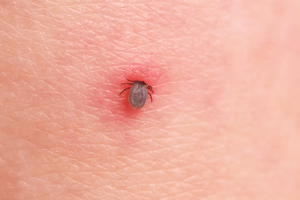For this month’s article, I’m reviewing a hodgepodge of miscellaneous tips for common problems.
By Eva Briggs
Ticks
 Summertime is here and ticks are out in full force. People come to the urgent care because they’re not sure what to do if bitten by a tick.
Summertime is here and ticks are out in full force. People come to the urgent care because they’re not sure what to do if bitten by a tick.
Here is how to remove a tick. You need either good tweezers with a fine tip, or any one of a number of commercially available tick removal devices.
First, clean the tick bite with soap and water or an alcohol wipe. If using tweezers, grasp the tick as close to the head as possible and pull steadily and firmly straight up. You can use your other hand to provide counter pressure on the skin on either side of the tick. If using a tick removal device, such as a tick twister, apply it as close to the head of the tick as possible and gently twist while placing traction on the tick.
If a little bit of the tick’s head and mouthparts remain in your skin, don’t panic. Those remaining mouthparts are tiny, they’re not very deep in the skin, and they are not the portion that transmits Lyme disease. Trying to dig those parts out does more damage than letting them come out on their own. Simply apply warm packs several times a day and let the mouthparts work their way out.
If the tick is still alive, place it in a plastic bag and gently crush it to kill it before throwing it away so it won’t crawl out and attach to you or your pets. If the tick was attached for less than 24 hours and wasn’t engorged (filled with blood), you are done. You don’t need prescription medicine and you don’t need a blood test. There is some evidence that a single dose of an antibiotic, doxycycline will reduce the spread of Lyme disease from a tick attached longer than 24 hours and engorged. This medicine is approved for children over age 8 and adults.
It’s normal for a tick bite to be red immediately around the bite, like a nasty mosquito bite. The rash of Lyme disease enlarges gradually, sometimes clears in the center (bull’s-eye rash), and might occur at places distant from the tick bite. If this rash, called erythema migrants, happens, or you develop fever or joint pain, you need to seek medical care to be evaluated for tick-borne illnesses.
Sending the tick to the lab to look for Lyme disease generally isn’t helpful. You can place the tick into the freezer. If you become sick later, the tick can be analyzed for tick-borne illnesses at that time.
Lacerations
Next, let’s move on to lacerations. Direct pressure on the wound controls bleeding. If heavy bleeding continues, seek medical care. Once the bleeding has slowed down wash the wound with soap and water. This is the most important step. You don’t need peroxide. It can damage healthy tissue.
Kids swallowing pills
How do you teach a child or teenager to swallow pills? First, don’t tip your head way back when swallowing a pill. This closes off your throat. Put the pill on your tongue and then taking a sip of water through a straw or from a soda bottle. This places your mouth into a shape where pills slip down more easily. Practice first with small candies such as Jimmies, Tic Tacs or M&Ms. Children are generally less afraid of candy than of medicine. And once they’ve mastered the art they can eat and enjoy the remaining treat.
Eva Briggs is a medical doctor who works at two urgent care centers (Central Square and Fulton) operated by Oswego Health.

